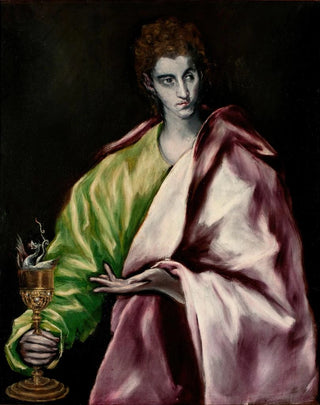Saint Jean l'Évangéliste - El Greco | Art print


View from behind

Frame (optional)
Saint John the Evangelist - El Greco – Captivating Introduction
In the vibrant universe of art, certain works transcend mere frames to become windows into bygone eras and profound thoughts. "Saint John the Evangelist - El Greco" is one of those creations that captivates and provokes reflection. This iconic piece, crafted by the Spanish master of Greek origin, El Greco, invites viewers to immerse themselves in intense spirituality and a unique aesthetic. The painting, both mystical and realistic, bears witness to a time when art was a means of expressing beliefs and human emotions. The depiction of Saint John, a central figure in Christianity, is imbued with psychological depth that fascinates and attracts.
Style and uniqueness of the work
El Greco's style is inimitable, at the crossroads between the Renaissance and the Baroque. In "Saint John the Evangelist," vibrant colors and elongated forms create an atmosphere that is both dramatic and contemplative. The saint's face, filled with serenity and wisdom, is highlighted by light plays that emphasize features and emotions. The color palette, dominated by deep blues and radiant golds, gives the work an almost supernatural dimension. Saint John's posture, along with the movement of his drapery, suggests an inner dynamism, a silent dialogue between the divine and the human. This painting is an invitation to meditation, a space where the viewer can lose themselves in thoughts and reflections.
The artist and his influence
El Greco, whose real name is Domenikos Theotokopoulos, left his mark on his era with a unique artistic vision that blends Byzantine influences and elements of the Italian Renaissance. Born in Crete, he settled in Toledo, where he developed his personal style, characterized by intense expressiveness and palpable spirituality. His innovative approach paved the way for many artists who followed him. Through his works, El Greco was able to translate complex emotions and theological concepts, thus influencing generations of artists, from the Baroque to Romanticism. His depictions of religious figures

Matte finish

View from behind

Frame (optional)
Saint John the Evangelist - El Greco – Captivating Introduction
In the vibrant universe of art, certain works transcend mere frames to become windows into bygone eras and profound thoughts. "Saint John the Evangelist - El Greco" is one of those creations that captivates and provokes reflection. This iconic piece, crafted by the Spanish master of Greek origin, El Greco, invites viewers to immerse themselves in intense spirituality and a unique aesthetic. The painting, both mystical and realistic, bears witness to a time when art was a means of expressing beliefs and human emotions. The depiction of Saint John, a central figure in Christianity, is imbued with psychological depth that fascinates and attracts.
Style and uniqueness of the work
El Greco's style is inimitable, at the crossroads between the Renaissance and the Baroque. In "Saint John the Evangelist," vibrant colors and elongated forms create an atmosphere that is both dramatic and contemplative. The saint's face, filled with serenity and wisdom, is highlighted by light plays that emphasize features and emotions. The color palette, dominated by deep blues and radiant golds, gives the work an almost supernatural dimension. Saint John's posture, along with the movement of his drapery, suggests an inner dynamism, a silent dialogue between the divine and the human. This painting is an invitation to meditation, a space where the viewer can lose themselves in thoughts and reflections.
The artist and his influence
El Greco, whose real name is Domenikos Theotokopoulos, left his mark on his era with a unique artistic vision that blends Byzantine influences and elements of the Italian Renaissance. Born in Crete, he settled in Toledo, where he developed his personal style, characterized by intense expressiveness and palpable spirituality. His innovative approach paved the way for many artists who followed him. Through his works, El Greco was able to translate complex emotions and theological concepts, thus influencing generations of artists, from the Baroque to Romanticism. His depictions of religious figures
12,34 €






